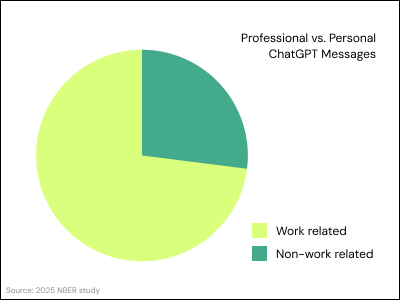Every second, while executives debate AI readiness in boardrooms, employees send 29,000 messages to ChatGPT. That's 700 million weekly users sending 2.5 billion messages daily. The surprising part? 73% of these interactions have nothing to do with work.
This finding comes from an NBER study that analyzed actual ChatGPT usage patterns with access to real usage data while maintaining privacy protocols. The AI revolution isn't coming - it's already happening, just not where most business leaders are looking.

Your employees are already using AI (they just haven't told you)
While organizations debate AI readiness, employees have already made a decision. The NBER data shows educated professionals in high-paying occupations are significantly more likely to use ChatGPT for work - on personal accounts, outside official channels.
The breakdown from the research:
- 37% of messages from users without bachelor's degrees are work-related
- 46% for those with bachelor's degrees
- 48% for those with graduate education
Knowledge workers have integrated AI into their workflows. They're just doing it quietly.
Everyone's using AI to write. Here's what that actually means.
Writing dominates professional AI use - 42% of all work-related ChatGPT messages as of June 2025. But here's the detail that matters: two-thirds of these writing tasks involve modifying existing text rather than creating from scratch.
What this looks like in practice: Your consultants are refining client communications. Your brokers are polishing proposals. Your analysts are summarizing complex documents. They're not replacing human judgment, they're using AI as quality control for their own work. For users in management and business occupations, writing accounts for 52% of all work-related messages. This isn't about automation; it's about refining output.
Decision support, not task replacement
One of the biggest insights from the NBER study was that 49% of all ChatGPT messages are "Asking" rather than "Doing." People primarily seek information, clarification, and advice to inform decisions. In professional contexts, this pattern becomes even stronger for educated users in technical roles.
When the research mapped messages to work activities, roughly two-thirds fell into informational and decision-support functions:
- "Getting Information" - 19.3%
- "Interpreting the Meaning of Information for Others" - 13.1%
- "Documenting/Recording Information" - 12.8%
- "Making Decisions and Solving Problems" - 8.5%
- "Thinking Creatively" - 9.1%
The study notes that ChatGPT "likely improves worker output by providing decision support, which is especially important in knowledge-intensive jobs where productivity is increasing in the quality of decision-making."
This matters for professional services. Every client recommendation, strategic analysis, or risk assessment can be enhanced by AI-powered decision support. The collaborative interactions grow faster than pure automation, suggesting users discover increasing value over time.
Three assumptions the data challenges
"AI is primarily for tech companies"
Only 4.2% of ChatGPT messages relate to computer programming. The dominant use cases: writing, information seeking, and practical guidance, are universal across industries. The study found remarkably similar usage patterns across occupations, from management to sales to administration.
"AI will replace our workforce"
The fastest-growing category is "Asking" questions to make better decisions. Quality ratings for these collaborative interactions consistently exceed those for pure automation tasks. Users aren't being replaced; they're being enhanced.
"We need custom AI solutions"
Nearly 80% of all ChatGPT usage falls into three categories: Practical Guidance, Writing, and Seeking Information. These aren't exotic use cases requiring specialized development, they're fundamental business activities that existing AI tools already handle.
What happens if you keep waiting
The NBER study's clearest finding: employees are already using these tools, competitors are capturing value, and the question isn't whether to implement AI but how to channel existing usage into something strategic. A "wait-and-see" approach to policy doesn't protect you, it just makes you blind to what's happening.
Non-work AI usage is growing faster than work usage. Your employees and clients are becoming AI-native in their personal lives while their AI experience in a professional context lags behind.
Adoption with these tools has already been moving at breakneck speed:
- November 2022: ChatGPT launches
- December 2022: 1 million users in 5 days
- November 2023: 100 million weekly active users
- July 2025: 700 million weekly active users sending 18 billion messages weekly
This isn't gradual adoption. Each of those milestones represents a fundamental shift in how people expect to interact with information.

Without an official policy, employee AI use becomes a hidden liability. Data security, intellectual property, and client confidentiality are all at risk when employees use personal accounts and unvetted tools. The urgent issue isn't AI's potential, it's the risks and missed opportunities of ignoring its current reality.
So what do you actually do about this?
Your employees are already AI users. The advantage lies in turning their existing usage into something the organization can benefit from. Based on the research, here's what seems to work:
Stop banning, start governing. Create a formal AI use policy that defines clear boundaries. Specify what types of data are off-limits (sensitive client information, proprietary code), which platforms are sanctioned, and what ethical standards must be met. This channels shadow IT into a secure, controlled environment rather than pretending it doesn't exist.
Provide sanctioned tools and training. Your employees want to use AI, so give them a company-approved way to do it. Invest in enterprise-grade AI subscriptions or internal platforms that offer enhanced security and data privacy. Pair this with training focused on the high-value use cases the research validated: writing refinement, decision support, and information synthesis.
Document and formalize workflows. With writing and information-seeking dominating professional AI use, standardize AI-enhanced workflows to maximize ROI. Your knowledge workers are likely already doing this. Bring their expertise into official channels and formalize these practices.
The data shows that successful AI implementations aren't top-down mandates from IT teams but grassroots initiatives led by line managers and employees who understand the day-to-day work.
The costs of waiting
The 700 million people using ChatGPT aren't early adopters anymore, they're the mainstream. For service-based businesses, the implications are straightforward: clients increasingly expect AI-enhanced service delivery, employees expect AI-augmented workflows, and competitors are already implementing both.
The research shows educated, professional workers drive workplace AI adoption through billions of messages weekly. The question isn't whether your business will adopt AI but whether you'll lead that adoption or follow it.
Every week of delay means employees develop AI expertise outside your organization's processes, competitors accumulate implementation experience, and markets evolve toward new capability expectations.
AI implementation isn't a future strategy decision, it's a current operational reality. The choice is whether you'll shape how AI transforms your business or let it happen without you.

